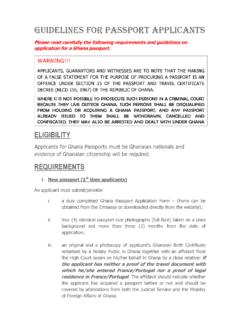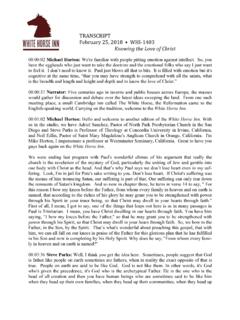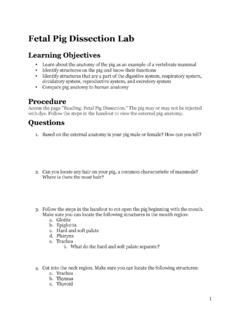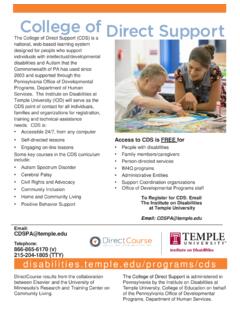Transcription of Proximal Hip Fracture Open Reduction/Internal Fixation …
1 1 Proximal Hip Fracture open Reduction/Internal Fixation and Rehabilitation Surgical indications and Considerations Anatomical Considerations: The hip is a ball and socket joint with the femoral head aligned towards the pelvic acetabulum. Stability of this joint is achieved by the surrounding ligaments and musculature that attach the pelvis to the femur. The medial and lateral femoral circumflex arteries supply the femoral neck and head with a majority of its blood supply. Fractures of the femoral head pose a threat to the vascular supply of this structure. However, displaced Fracture of the femoral neck can occur with no disruption to the blood supply.
2 Pathogenesis: Femoral neck fractures occur more often in the elderly population secondary to a fall or twisting injury. It is estimated that femoral neck fractures account for approximately one half of the hip fractures in the elderly. These fractures also have a higher incidence in women possibly secondary to osteoporosis being the most significant contributing factor in this type of injury. Femoral neck fractures in the young population (usually in their third or fourth decade) are primarily a result of a high impact, high energy trauma. Epidemiology: Contributing factors that increase the risk of sustaining a Proximal hip Fracture include, osteoporosis, malnutrition, decreased physical activity, impaired vision, neurological diseases, poor balance, altered reflexes, and muscle atrophy.
3 The number of hip fractures in the United States has doubled from the mid-1960s through the 1980s with 250,000 cases per year. By 2005 it is expected that this number will triple secondary to the increasing number of geriatric patients. Fractures of the Proximal femur are classified by anatomical location. The most common types are: Femoral neck Fracture intertrochanteric Fracture Subtrochanteric Fracture (typically seen in younger patients secondary to traumatic injuries - accounting for less than 5 percent of cases in elderly patients) Diagnosis: Diagnosis of hip Fracture is often uncomplicated, especially when the bone fragments are displaced Radiographs should be ordered for any elderly patient who complains of even mild hip pain after a fall.
4 Note: Nondisplaced femoral neck fractures and fractures of just the acetabulum might not be visible on plain films so further test such as a bone scan or an MRI may be required. Exquisite pain upon weight bearing Patient typically present with the fractured leg held in external rotation (frog position) Loma Linda University and University of Pacific Doctorate in Physical Therapy Programs Joe Godges DPT, MA, OCS 2 The patient s leg may be shortened if the Fracture is displaced. Key question: Why did the patient fall? Underlying factors may include an underlying infection, myocardial ischemia, or gastrointestinal bleeding, altered medications as well as the contributing factors mentioned above (osteoporosis, malnutrition, decreased physical activity, impaired vision, neurological diseases, poor balance, altered reflexes, and muscle atrophy).
5 Nonoperative versus Operative Management: There are some cases in which nonoperative management is the treatment of choice. Individuals who are non-ambulatory or who are medically unstable may opt for nonoperative management such as traction just long enough to allow for early healing. Traction is followed by bed to chair mobilization. If a nonoperative approach is chosen, patients may have to wait for sufficient bone healing which may take up to 16 weeks before ambulating. Surgical Procedure: It is critical that the open reduction internal Fixation (ORIF) be performed as soon after the injury as possible, preferably within 24 to 48 hours in order to prevent disruption on the vulnerable blood supply.
6 Femoral neck pinning consists of placing multiple screws across the fractured femoral neck. The most commonly used technique is a lateral approach, while a percutaneous technique may also be used. The type of procedure is dependent on the Fracture and includes the following: For nondisplaced or impacted femoral neck fractures an in situ Fixation with multiple parallel screws or pins is used For stable intertrochanteric fractures a dynamic extramedullary Fixation with a sliding hip screw and a lateral side plate is used allowing for compression along the Fracture site during early weight bearing For subtrochanteric fractures a static interlocking intermedullary nail Fixation or a sliding hip screw combined with an intermedullary nail is used There are many types of screws available for this procedure but typically the orthopedic surgeon will use a solid or
7 Cannulated screw made or either stainless steel or titanium. In order to minimize postoperative complications, it is recommended that the screws be placed accordingly: The pins should be placed within the central two thirds of the femoral head The central screw should be placed with the tip of the screw no closer than 5 mm to the subchondral bone One inferior screw should be placed along the medial femoral neck The inferior screw should exit at or above the lesser trochanter Two Proximal screws should be placed in a triangular configuration anteriorly and posteriorly (if the screws are placed to close together the strength of the Fixation is compromised) Preoperative Rehabilitation.
8 Preoperative rehabilitation is not particularly relevant for patients who have sustained a Proximal hip Fracture and are status post an ORIF procedure, simply because these fractures are mainly secondary to a trauma such as a fall. Surgery is indicated during the first 24 to 48 hours after the injury in order to prevent any possible or further disruption to the vascular supply. Prior to the surgery certain precautions may be taken to Loma Linda University and University of Pacific Doctorate in Physical Therapy Programs Joe Godges DPT, MA, OCS 3prevent further injury such as: Adequate medication and proper positioning to minimize the patient s pain Non-weight bearing status and instructions on the appropriate assistive devise (most likely a front wheel walker for safety considering the majority of Proximal hip Fracture patient are older adults) Instructions/review of post-operative rehabilitation plan POSTOPERATIVE REHABILITATION.
9 Stages of Fracture Healing: 1. Impact 2. Induction 3. Inflammation 4. Soft tissue callus (chondroid) 5. Hard tissue callus (osteoblastic) 6. Remodeling Possible Signs of Failure of the ORIF: Sever groin thigh or knee pain that increased with movement or weight bearing Shortening of the involved limb that was not present immediately after surgery Constant external rotation of the involved limb Positive Trendelenburg sign with weight bearing that does not resolve or significantly decrease with strength training Phase I: Acute Stage/Immediately Postoperatively 1-2 weeks Goals: Prevent wound complications Decrease Acute symptoms (control pain and edema) NWB precautions Teach self management especially transfer skills and avoid movements that stress the Fracture or surgery site Improvement of ambulation skills using assistive devices as indicated Facilitation and neuromuscular control of stabilizing muscles (core stability) Safely perform ADL s Prevention of DVT s Prevention of hip flexor contractures Intervention.
10 Ankle pumps PROM and AAROM of affected limb Loma Linda University and University of Pacific Doctorate in Physical Therapy Programs Joe Godges DPT, MA, OCS 4 Passive stretching Practice correct posture with transfers and gait training with NWB precautions to prevent development of a faulty hip posture Assistive devise training Transfer training Gait training Progress sitting tolerance Progress standing tolerance Progress walking tolerance with weight-bearing precautions and assistive device Phase II: Subacute Stage: 2 6 weeks post-op Goals: Increase mobility Increase neuromuscular control on postural muscles Increase strength and neuromuscular control of affected limb Learn safe body mechanics Increase functional skills Progress weightbearing precautions to touchdown weightbearing and partial weightbearing Progress walking distance with appropriate assistive devise and weight bearing precaution Intervention.









